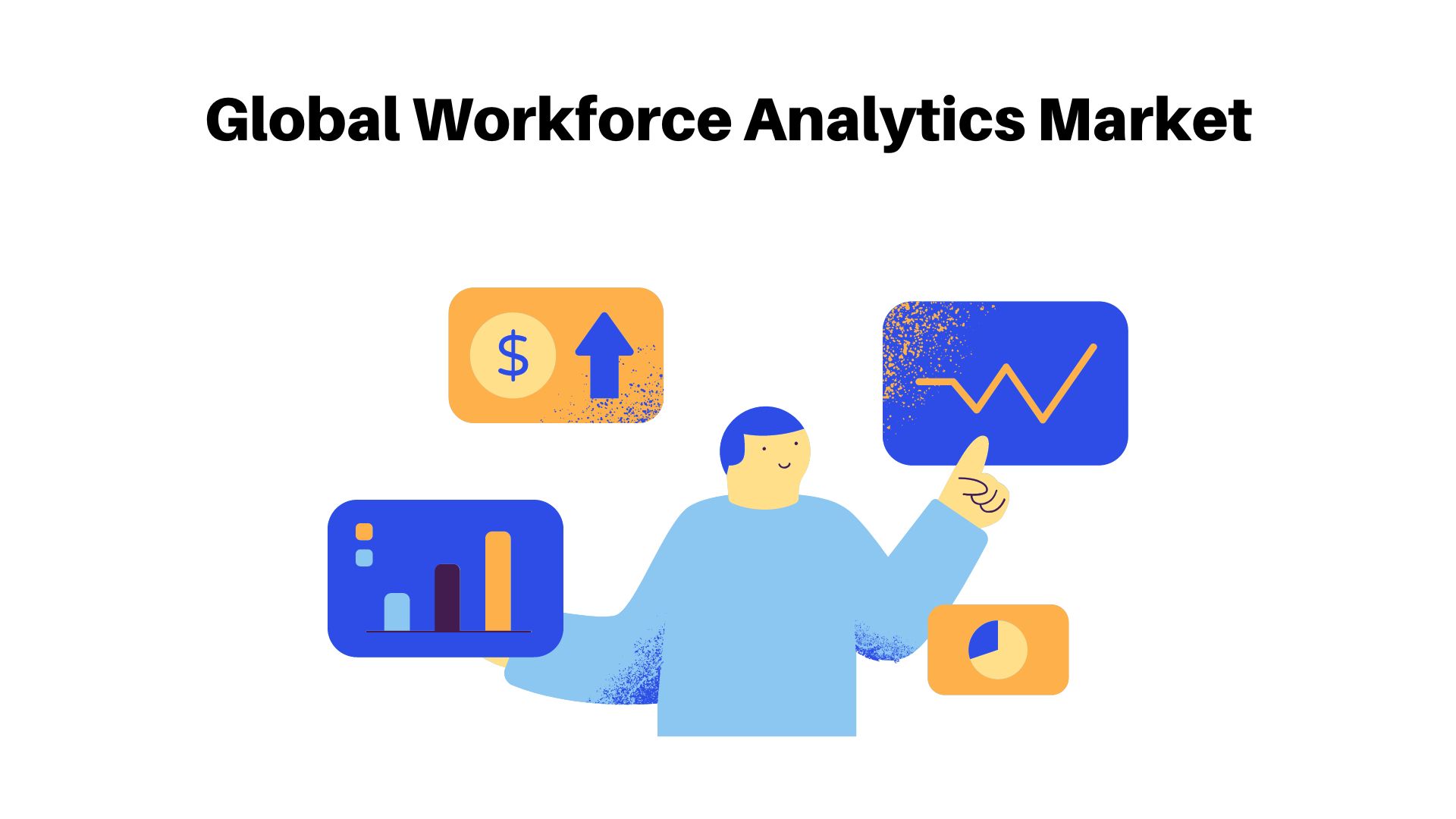Global Workforce Analytics Market Peer Group Analysis and Revenue (16.5%) by 2032

Page Contents
According to Market.us (Prudour Research), the global workforce analytics market will grow at an average CAGR of 16.5% over the next ten years and will reach USD 5.44 billion in 2032 from USD 1.18 billion in 2022.
Workforce analytics is the use of data analytics tools to optimize and analyze an organization's workforce performance. This market is driven by an increasing demand for data-driven solutions in HR to increase employee productivity, lower costs, and improve organizational efficiency. Market growth will also be driven by the rapid emergence of advanced technologies like machine learning, predictive analytics, and artificial intelligence.
Workforce analytics refers to the analysis and interpretation of data related to an organization’s workforce to optimize workforce management, increase productivity, lower costs, and improve overall organizational performance.
The Analytics of the workforce involves data mining, statistical analysis, and machine learning. These techniques are used to identify patterns and insights in various HR metrics, such as retention, recruitment, training, employee engagement, and performance.
Would you like to access the statistical information, graphs, and key players' tactics? click here| https://market.us/report/workforce-analytics-market/request-sample
Key Takeaways
The demand for data-driven HR solutions is driving the global workforce analytics market to grow at a rapid pace.
Due to its flexibility, scalability, and cost-effectiveness, cloud-based deployment is expected to hold the largest market share.
Due to the increasing use of workforce analytics solutions, small and medium-sized businesses (SMEs) will experience the greatest growth.
North America will hold the largest market share, due to its high adoption rate for workforce analytics solutions.
Asia-Pacific is predicted to experience the highest growth rate due to the increasing adoption of cloud-based solutions and growing awareness among small and medium-sized enterprises (SMEs) regarding the advantages of workforce analytics.
Workforce analytics utilizes data mining, statistical analysis, machine learning, and predictive modeling techniques to uncover trends, patterns, and insights related to various HR metrics.
By leveraging workforce analytics, organizations can make data-driven decisions and take proactive measures to address workforce-related issues such as skills gaps, turnover rates, and absenteeism.
Workforce analytics solutions can be deployed both on-premises or through cloud-based platforms, with customization available for different organizations based on their unique requirements.

Regional Snapshot
- North America: North America is expected to dominate the workforce analytics solutions market due to the high adoption rate in this region. The United States leads this region, boasting a large number of leading vendors, increasing demand for data-driven HR solutions, and an emerging trend of workforce optimization.
- Europe: Europe is expected to experience significant growth in the workforce analytics market due to the increasing adoption of cloud-based solutions and an uptick in workforce optimization initiatives. Major markets include the United Kingdom, Germany, and France.
- Asia-Pacific: The Asia-Pacific region is expected to experience the highest growth rate in workforce analytics, due to the increasing adoption of cloud-based solutions and growing awareness among small and medium-sized enterprises (SMEs) regarding its advantages. China, India, Japan, and Australia are some of the key markets within this region.
- Middle East and Africa: The Middle East and Africa region is expected to experience rapid growth in the workforce analytics market due to increasing adoption of solutions designed to optimize employee performance and boost organizational efficiency. Major markets within this region include UAE, Saudi Arabia, and South Africa.
- Latin America: Latin America is expected to experience moderate growth in the workforce analytics market due to the increasing adoption of cloud-based solutions and an uptick in workforce optimization initiatives. Brazil, Mexico, and Argentina are some of the key markets within this region.
Market Dynamics
Drivers
- Data-Driven HR Solutions: The demand for accurate, real-time insights into workforce performance and productivity is driving the adoption of workforce analytics solutions.
- Advancements in Technology: Cutting-edge technologies such as machine learning, artificial intelligence, and predictive analytics offer organizations a deeper insight into their workforce and enable them to make data-driven decisions.
- Rising Trend of Workforce Optimization: Organizations are increasingly focusing on optimizing their workforce to increase productivity, reduce expenses and enhance organizational efficiency.
- Cloud-based workforce analytics solutions are becoming more and more popular with organizations of all sizes due to their scalability, adaptability, and cost-efficiency.
- Small and Medium-Sized Enterprises (SMEs) are becoming more aware of the advantages of workforce analytics solutions, which is driving their adoption in this market segment.
- Organizations recognize the need for improved talent management: With fiercer competition for top talent, organizations are turning to workforce analytics in order to better plan and execute their talent acquisition and retention initiatives.
- Compliance and Regulatory Needs: Organizations are increasingly turning to workforce analytics solutions in order to guarantee compliance with labor laws and regulations, such as those related to equal opportunity employment practices and labor reporting.
Restraints
- Data Privacy and Security Concerns: Workforce analytics solutions involve the use of employee data, raising concerns about data privacy and security. Organizations must guarantee their workforce analytics solutions abide by data protection regulations while safeguarding employee confidentiality.
- Lack of Skilled Personnel: Successful implementation and management of workforce analytics solutions necessitate a highly skilled workforce with expertise in data analysis, machine learning, and predictive modeling. Unfortunately, the shortage of such professionals could pose a barrier to growth for the market.
- Implementation and maintenance costs: Adopting and running workforce analytics solutions can be expensive, especially for small to medium-sized enterprises. The high costs can be an impediment to adoption in price-sensitive markets.
- Integration with Legacy Systems: Many organizations possess legacy HR systems that may not be compatible with modern workforce analytics solutions. This poses difficulties when integrating and analyzing data from various sources, potentially impeding the adoption of workforce analytics solutions.
- Lack of Awareness and Understanding: Despite the potential benefits of workforce analytics solutions, many organizations may not be aware of their capabilities or how to use them for HR process improvement. This can obstruct adoption rates significantly, particularly among small and medium-sized enterprises.
View Detailed TOC of the Report | https://market.us/report/workforce-analytics-market/table-of-content/
Opportunities
- Rising Demand for Real-Time Workforce Analytics: As companies seek more timely insights into employee performance, there is an increasing demand for workforce analytics solutions that offer real-time data visualization and analysis.
- Integration with Artificial Intelligence and Machine Learning: Combining workforce analytics with artificial intelligence and machine learning technologies can give organizations a deeper insight into employee performance and productivity, allowing them to make data-driven decisions with confidence.
- Expansion into New Industry Verticals: While the workforce analytics market has traditionally been focused on HR functions, there is an opportunity to expand into other industry verticals such as healthcare, retail, and finance where workforce analytics can help optimize employee performance and productivity.
- Growing Demand for Predictive Analytics: The rise of predictive analytics is creating new business opportunities for workforce analytics vendors, as organizations seek to use data to anticipate future patterns and make better-informed decisions.
- Focus on Employee Engagement: Workforce analytics solutions can be utilized to increase employee satisfaction and well-being by recognizing factors like workload, work-life balance, and professional development opportunities.
- Adoption by Small and Medium-Sized Enterprises: While workforce analytics solutions have traditionally been popular with larger corporations, there is now a chance to expand into the small and medium-sized enterprise market by offering cost-effective cloud-based solutions tailored for this segment.
Challenges
- Data Quality and Accessibility: Accuracy and availability of workforce data are essential for effective workforce analytics. Unfortunately, many organizations struggle with data quality and accessibility issues, particularly when integrating information from multiple sources.
- The complexity of Data Analysis: Workforce analytics requires complex techniques like machine learning and predictive modeling that require specialized personnel with expertise. Unfortunately, the shortage of such professionals can pose a challenge to organizations looking to implement workforce analytics solutions.
- Integration with Legacy Systems: Many organizations still rely on outdated HR systems that may not be compatible with modern workforce analytics solutions. This poses difficulties when integrating and analyzing data from various sources, creating a hurdle to adoption.
- Data Privacy and Security Concerns: The use of employee data in workforce analytics solutions raises serious privacy and security risks, particularly given the escalating data protection regulations.
- Resistance to Change: Implementing workforce analytics solutions may require significant adjustments to current HR processes and workflows. This may cause unrest among employees, especially if they feel the changes are in jeopardy of their job security or privacy rights.
- Lack of Awareness and Understanding: Despite the growing importance of workforce analytics, many organizations may still not be aware of its capabilities or how to effectively use it for improving HR processes. This could significantly limit adoption rates among small and medium-sized enterprises (SMEs).
Key Market Segments
Type
- <100 employees
- 100-499 employees
- 500-999 employees
- 1,000-4,999 employees
- >5000 employees
Application
- On-premises
- Saas Cloud-Based
Key Market Players
- Kronos
- Infor
- Verint
- NICE Systems
- Aspect
- Workforce Software
- Clicksoftware
- Calabrio
- ATOSS
- Genesys
- Monet Software
- InVision AG
- Teleopti
Recent Development
- September 2022: ActivTrak and Google Workspace announced a collaboration to offer personal work insights that empower employees to enhance their digital work habits and wellness. Customers can embed individual work metrics directly into their Google Workspace applications with ActivTrak for Google Workspace, giving employees real-time visibility to help redesign their day, protect focus time, and boost wellbeing.
- August 2022: ADP has unveiled Intelligent Self-Service, which assists employees with common problems before they need to reach out for HR support. By analyzing data across ADP's ecosystem, this product utilizes predictive analytics and machine learning algorithms to anticipate which problems may arise.
Report Scope
| Report Attribute | Details |
| The market size value in 2022 | USD 1.18 Bn |
| Revenue Forecast by 2032 | USD 5.44 Bn |
| Growth Rate | CAGR Of 16.5% |
| Regions Covered | North America, Europe, Asia Pacific, Latin America, and Middle East & Africa, and the Rest of the World |
| Historical Years | 2017-2022 |
| Base Year | 2022 |
| Estimated Year | 2023 |
| Short-Term Projection Year | 2028 |
| Long-Term Projected Year | 2032 |
Frequently Asked Questions
Q. What is the market size of the Workforce Analytics Market?
A: The Global Workforce Analytics Market was valued at USD 1.18 billion in 2022 and is expected to grow at a CAGR of 16.5% during the forecast period of 2023-2032 to reach USD 5.44 billion.
Q. What are the key segments of the Global Workforce Analytics Market?
A: The Workforce Analytics Market can be segmented By type (<100 employees, 100-499 employees, 500-999 employees, 1,000-4,999 employees, >5000 employees), By Application (On-premises, Saas Cloud-Based).
Q. Who are the key players in the Global Workforce Analytics Market?
A: Some of the key players operating in the Workforce Analytics Market include Kronos, Infor, Verint, NICE Systems, Aspect, Workforce Software, Clicksoftware, Calabrio, ATOSS, Genesys, Monet Software, InVision AG, Teleopti.
The team behind market.us, marketresearch.biz, market.biz and more. Our purpose is to keep our customers ahead of the game with regard to the markets. They may fluctuate up or down, but we will help you to stay ahead of the curve in these market fluctuations. Our consistent growth and ability to deliver in-depth analyses and market insight has engaged genuine market players. They have faith in us to offer the data and information they require to make balanced and decisive marketing decisions.



